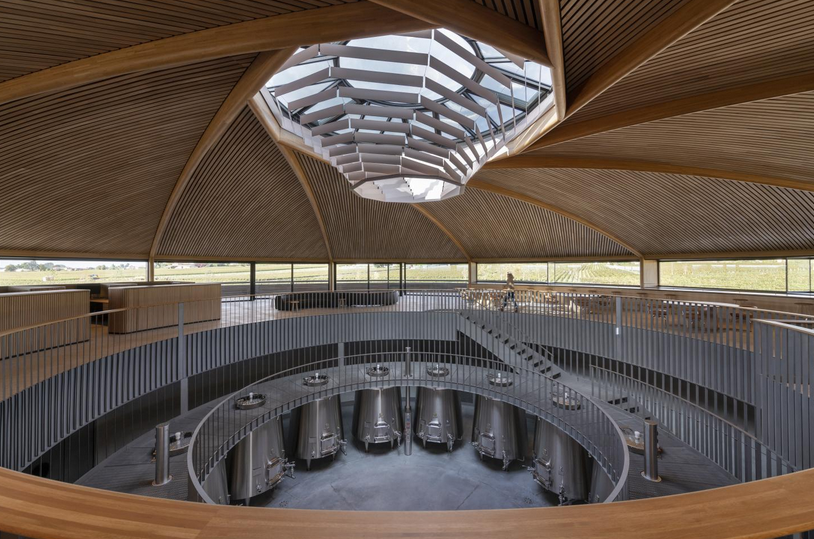
The World of Fine Wine’s Simon Field MW is in Bordeaux for the 2021 vintage en primeur tastings. In the latest of his dispatches from the region, he gives his verdict on the “last of the garagistes,” St-Emilion’s Le Dôme.
“We are poor peasants,” says Jean-Pierre Morgues of Le Dôme, pointing up the hill towards neighbors Angélus and Canon.
An impecunious plight is not the first thing that comes to mind when surveying his fabulous revamped winery, a magnificent concentric design by Lord Foster, the spirit of Guggenheim its inspiration, the shape of the barrels its leitmotif.
Environmentally efficient and fantastically functional on all levels, this must be the sine qua non of a modern cuverie, certainly in France, its audacious modernity all the more impressive for its discreet bearing and the facility of its assimilation within its surroundings.
A triumph of architectural ingenuity, and one would be remiss in neglecting to speculate as to whether a similar approach has informed the style of wine itself.
Here we are entering murkier waters. Le Dôme, from the outset, aspired to re-conjugate the grammar of St-Emilion, to conspire with the coterie which included Valandraud, Troplong Mondot, and others and radically to change the style and perception of its wines.
Aided by Robert Parker (Le Dôme is not shy about reminding us that it has been awarded 100 points) the property rode on the crest of an indulgent but richly satisfying wave.
Those who argue that waves must by definition crash onto the shore may well have underestimated the lasting impact of this movement.
Keeping the Bordeaux modernist flame burning?
What is most striking to me, tasting in the less opulent vintage of 2021, is that Le Dôme seems to be the virtually the last strict custodian of this particular creed.
Whereas the wines from Valandraud and Troplong Mondot, inter alia, have changed appreciably over the last few years, Le Dôme seems prepared to go it alone, albeit without quite the same cavalier indulgence in the winery.
Head winemaker Neil Whyte will no longer use 200 percent of new oak as a matter of course, but, after 25 years, his mission statement remains fundamentally the same.
To the casual observer, whether or not he or she likes the style (richly textured, relatively high pH, toasty, and demonstrably high in alcohol), there must surely be benefits in the fundamental tenets of choice and diversity.
Jonathan Maltus, the owner of Le Dôme, would not be especially irritated to be described as a risk-taking entrepreneur; the man who has changed course so many times in his extraordinary career, yet who, may well, for once, decide to hold the line, to risk flirting with potential unpopularity and to see where that leads
Neither Darwinian, or, heaven forfend, Malthusian, but maybe, counter-intuitively, rather a sound move.
2021, says Jean-Pierre, was “ideal” for Le Dôme, despite the “terrible frosts” on April 7th and 8th, and despite the mildew which reduced the subsequent crop volume by double digit figures for both key varietals.
The key, to him, was waiting to harvest, in defiance of the insistent forecasts of heavy rain—heavy rain which failed to materialize.
“This is what made the vintage for us. The longer period between veraison and harvest has ensured a full phenolic ripening and a correct and harmonious balance in the wines.”
“I am not sure that all of our neighbors were as patient as us,” he adds, looking up the hill once more.
The results do not lack for plush, for weight, and for style, and deserve a heart-felt cheer for holding onto the baton of the latterly oft-maligned garagiste style.
As the building itself reminds us, what goes around comes around, and often with even more impact the second time around.
2021 Le Dôme St-Emilion Grand Cru
(80 percent Cabernet Franc, 20% Merlot)
It is rumored that Thomas Duclos, consultant enologist with a first-rate track record at Figeac and elsewhere, has subtly changed the style of Le Dôme. Very, very subtly, I should say.
The numbers underwrite the style; a highish pH of 3.71 and 80 percent malolactic in new French oak (it used to be 100 percent I suppose).
Probably the least “unreformed” of the so-called garagiste wines, Le Dôme nonetheless plays to its audience. From the deep purple robe to the fantastically ripe fruit, most of it black and blue, one is lured into the stately pleasure dome. But is this Coleridge’s milk of paradise?
It may well be!
Bordeaux 2021 coverage
Bordeaux 2021 en primeur: Romance and reality
Bordeaux 2021 Field Notes: Château Figeac
Bordeaux 2021 Field Notes: Vieux Château Certan
Bordeaux 2021 Field Notes: Château Pavie
Bordeaux 2021 Field Notes: Le Dôme
Bordeaux 2021 Field Notes: Domaine de Chevalier
Bordeaux 2021 Field Notes: Sauternes and Barsac
Bordeaux 2021 Field Notes: Pichon Lalande
Bordeaux 2021 Field Notes: Enquiring Minds
Bordeaux 2021 Field Notes: The Whites Have It






